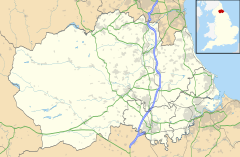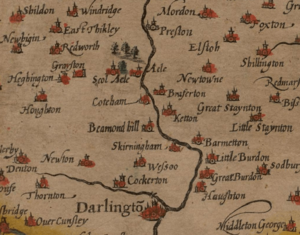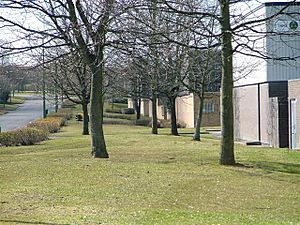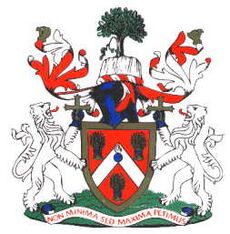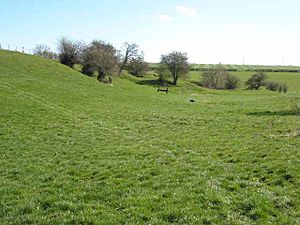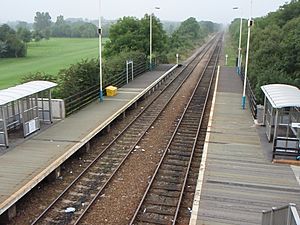Newton Aycliffe facts for kids
Quick facts for kids Newton Aycliffe |
|
|---|---|
| Town | |
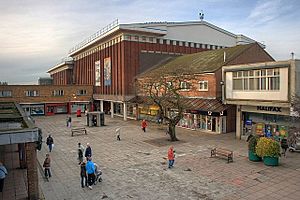 The town centre |
|
| Population | 26,415 (2021) |
| OS grid reference | NZ2724 |
| Civil parish |
|
| Unitary authority |
|
| Ceremonial county | |
| Region | |
| Country | England |
| Sovereign state | United Kingdom |
| Post town | NEWTON AYCLIFFE |
| Postcode district | DL5 |
| Dialling code | 01325 |
| Police | Durham |
| Fire | County Durham and Darlington |
| Ambulance | North East |
| EU Parliament | North East England |
| UK Parliament |
|
Newton Aycliffe is a town in County Durham, England. It was started in 1947 under a special law called the New Towns Act. This law helped create new towns after World War II.
The town is about 5 miles (8.0 km) north of Darlington. It is also about 10 miles (16 km) south of Durham. Newton Aycliffe is the oldest "new town" in the north of England.
It is part of a larger area called the civil parish of Great Aycliffe. This area includes Aycliffe Village to the south and part of School Aycliffe to the west. In 2021, about 26,415 people lived in Newton Aycliffe.
Contents
History of Newton Aycliffe
Early History: Anglo-Saxons
Before Newton Aycliffe was built, the area was an Anglo-Saxon settlement. Its old name was 'Acley'. This name came from Old English words. 'Ac' meant oak, and 'ley' meant 'a clearing'. So, it was a clearing with oak trees.
Important church meetings called synods happened in Aycliffe in 782 AD and 789 AD. The town's motto is in Latin. It means "Not the Least, but the Greatest we seek."
Transportation Links
The Stockton and Darlington Railway branch line runs near the town. This railway was built in 1825. George Stephenson's famous steam train, Locomotion No 1, was first put on the tracks near Newton Aycliffe.
The main road, the Great North Road (A1), used to go through the town. But in 1969, a new road was built around it.
World War II and the "Aycliffe Angels"
During World War II, Aycliffe was very important for making ammunition. Huge factories were built here. They were covered with grass to hide them from enemy planes. These factories were connected by nearby railway lines.
Thousands of women worked in these dangerous factories. They were bravely called the "Aycliffe Angels".
The Beveridge Report and a New Vision
After World War II, the government asked William Beveridge to plan for Britain's future. In 1942, he wrote a report. He said five big problems affected people: poverty, disease, homelessness, ignorance, and unemployment.
To fix these, Beveridge suggested a system of social security, a National Health Service, council housing, free education, and full employment. He called this the Welfare State. It started in Britain in 1948.
Beveridge chose an area of moorland between Aycliffe and Middridge for a special project. This became Newton Aycliffe, his main "new town." It was meant to show what his vision for Britain could be. Beveridge even lived in Newton Aycliffe for a while.
Local Industries and Jobs
The old ammunition factories were later used for other types of manufacturing. This area became the town's industrial district. Many companies moved here after the war.
Some big employers in the past included Great Lakes Chemicals, Eaton Axles, and B.I.P. Eaton Axles moved to Poland, and B.I.P. is now Hydro Polymers. Union Carbide was taken over by STC, then Sanyo, but has now closed.
Today, companies like Flymo, 3M, Ebac, and Ineos (which took over Hydro Polymers) are in the town. There are also many smaller factories. Gestamp Tallent is one of the largest factories.
In 2015, Hitachi opened a large factory in Newton Aycliffe. They build railway trains there and employ 720 people.
How Newton Aycliffe is Governed
Great Aycliffe used to be part of a bigger old parish called Aycliffe. This included other villages like Brafferton.
From 1974 to 2009, Great Aycliffe was in the borough of Sedgefield. It was the largest town in that borough.
Since April 2009, Newton Aycliffe has been run by two main groups. These are the Great Aycliffe Town Council and the County Durham Unitary Authority.
Geography of Newton Aycliffe
In 2001, Great Aycliffe had about 26,385 people. By 2007, the Town Council said this number had grown to 29,000. It is the biggest town in the Sedgefield area.
Within 10 miles (16 km) of Newton Aycliffe, there are other towns and villages. These include Darlington, Bishop Auckland, Shildon, and Heighington. The village of Aycliffe is south of the town. The "Newton" in Newton Aycliffe means "New Town."
Aycliffe Village is close to the A1(M) motorway. This is where it meets the A167 road.
Woodham Area
Woodham was once a medieval village. Today, only a few small earth mounds remain from the original village. It was located north of the Woodham Burn stream. The A167 road now cuts through the old village site.
It is believed that the Scots burned the village during wars in the late 1200s and early 1300s. It was not rebuilt after that. However, some buildings appeared in the 1700s and 1800s. Some of these are still there today.
In the 1700s, there was a small stone quarry in Woodham. Most of its buildings were taken down by the late 1800s.
Woodham remained a small hamlet until the late 1970s and early 1980s. Then, Newton Aycliffe began to grow. Many farms in Woodham were demolished to make way for new houses.
Newton Aycliffe was first built with mostly social housing. Now, many of these homes are privately owned. Woodham is the largest area of private housing built since the late 1970s. It is north of the Woodham Burn, which used to be the town's northern edge.
Newton Aycliffe kept growing until 1980, when the council stopped building new council homes. Since then, private companies and housing associations have built homes. In the early 1980s, Woodham Village was built. It has a community center, a church, shops, and a pub called The Huntsman. The Woodham Golf and Country Club is also nearby.
Woodham Way is the main street in Woodham. It has shops like dentists, takeaways, and newsagents. Woodham is close to the town center and supermarket. More houses have been built recently, making the village even bigger.
Economy and Businesses
The town has a large industrial estate south of the town. It is split into three parts:
- Heighington Lane Business Park: Lidl has a main distribution center here. RF Micro Devices is also located here. This plant used to be a factory for Fujitsu. It makes electronic parts called wafers.
- Aycliffe Industrial Estate
- Aycliffe Industrial Park: This part is closest to the town.
The Ineos plant, which used to be the Hydro Polymers PVC plant, is near the railway.
Education in Newton Aycliffe
Newton Aycliffe has many schools for different ages:
- Aycliffe School – North East Centre for Autism – Website
- Aycliffe Village Primary School – Website
- Byerley Park Primary School – Website
- Greenfield Academy – Website
- Heighington Church of England Primary School
- Horndale Infant School
- St Francis Church of England Junior School
- St Joseph's Roman Catholic Voluntary Aided Primary School
- St Mary's Roman Catholic Voluntary Aided Primary School – Website
- Stephenson Way Community Primary School – Website
- Sugar Hill Primary School
- Vane Road Primary School – Website
- Woodham Burn Infant School
- Woodham Burn Junior School – Website
- Walworth School Blue bell Way
- Woodham Academy – Website
In the past, Milton and Marlow Hall's were two secondary schools. They joined together in 1971 to become the Avenue Comprehensive. This school closed in 1992. The site is now a Tesco Extra supermarket.
Colleges in the area include:
- Thornbeck College – North East Autism Society – Website
- Bishop Auckland College – Home – Bishop Auckland College
Media and News
Local news and TV signals for Newton Aycliffe come from BBC North East and Cumbria and ITV Tyne Tees. TV signals are received from the Bilsdale or Pontop Pike TV transmitters.
Local radio stations include BBC Radio Tees, Capital North East, and Aycliffe Radio. Aycliffe Radio is a community station that broadcasts from the town.
The town also has local newspapers like The Northern Echo and Aycliffe Today. The Newton News is the town's local community magazine.
Transportation in Newton Aycliffe
Railway Travel
Newton Aycliffe railway station is on the Tees Valley Line. Trains run by Northern Trains go to Bishop Auckland, Darlington, and Saltburn.
You can connect to other train services at Darlington. These include London North Eastern Railway trains to Edinburgh Waverley and London Kings Cross.
Road Connections
The A167 is the main road into town. It used to be part of the A1. This road goes north to Durham and Newcastle upon Tyne (about 30 miles). It goes south to Darlington (about 8 miles) and Northallerton.
The A1(M) motorway, which connects Edinburgh and London, passes near the town. It offers another way to get to Durham and Newcastle. The A689 is also nearby. It goes west to Bishop Auckland and east to Hartlepool and Teesside.
Bus Services
Arriva North East provides bus services in the town. You can take buses to Bishop Auckland, Durham, Darlington, and other nearby towns. Hodgsons' service 17 provides bus routes within the town itself.
Healthcare Services
The closest Accident and Emergency department is at Darlington Memorial Hospital. This hospital can help with chest pain, breathing problems, headaches, and other general health issues.
For serious injuries like broken bones or severe stomach pain, Darlington hospital is equipped to help. For cancer treatments, people need to travel to the James Cook University Hospital in Middlesbrough.
There are also several care homes in the area, such as Woodham Grange and Woodham Lodge.
Notable People from Newton Aycliffe
Many interesting people have come from Newton Aycliffe, including:
- Ross Turnbull, a former goalkeeper
- Scott Mann, a film director
- George Courtney, a football referee
- Jason Steele, a goalkeeper
- Lewis Wing, a footballer
- Brian Atkinson, a former professional footballer and manager
- Danny Mellanby, a former footballer
- David Bryan, lead singer for the band Hotel FM
- Mark Gatiss, an actor, comedian, writer, and novelist
- Paul Magrs, a writer known for Doctor Who books
- Vic Reeves, a comedian, artist, actor, and TV presenter
- Kate Avery, a long-distance runner
- Darren Craddock, a former footballer
- Paul Howell, a Member of Parliament (MP)
Images for kids
See also
 In Spanish: Newton Aycliffe para niños
In Spanish: Newton Aycliffe para niños


